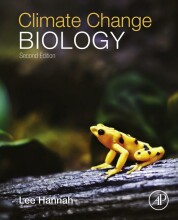Summary: Climate Change Biology | 9780127999234 | Lee Hannah
- This + 400k other summaries
- A unique study and practice tool
- Never study anything twice again
- Get the grades you hope for
- 100% sure, 100% understanding
Read the summary and the most important questions on Climate Change Biology | 9780127999234 | Lee Hannah
-
2 Climate system and climate change
This is a preview. There are 11 more flashcards available for chapter 2
Show more cards here -
What is climate change biology
The study of the impact of climte change on natural systems, with emphasis on understanding hte future impacts of human-induced climate change. -
What disciplines does climate change biology have?
Paleoecology, global change biology, biogeography and climatology. -
Whawt are the two most abundant greenhouse gases in the atmosphere?
CO2 and water vapor. Atmospheric Co2 concentrations resulting from human pollution is projected to cause major altertions to the earth's climate ystem and global mean temperature in the twenty-first century -
What is the greenhouse effect?
The Earth's atmosphere trap heat. Sunlight warms the Earths's surface, which then radiates long-wave radiation. Some of this radiation is adsorbed and reemitted by gases such as CO2 and water vapor. Part of the reemitted radiation is directed back at the Earth, resulting in a net redirection of long-wave radaition from space and back to Earth. This warms the lower reaches of the atmosphere, much as glass in greenhouse traps heat form the sun. -
How is the atmospheric increased by humans?
Primarily due to the burning of fossil fuels. Beginning with coal at the outset of the industrial evolution and transitioning to oil and natural gas as economies advances, the power for our electricity, indutry and transport has been drawn heavily from fossil fuels. Fossil fuels are rich in carbon, and burning them both releasses their stored energy and combines their carbon with oxygen to produce CO2 -
What is the climate system composed of?
Atmosphere
oceansearths land surfacehydrology
movement of gases including watervapor
solar energy / sun
variations in the earth's orbit in relation to the sun, shape and position of continents and oceans
Upper-level winds
ozone layer
snow and ice
soil mosture and temperature
land surface processes
realistic geography
sea ice
surface water winds
marine ecosystems
ocean bottom topography
vertical overturning
oceans currents, temperature and salinity
air-sea exchanges
human-produced emissions
atmospheric chemistry
evaporation
outgoing heat -
What the main constituents in the atmosphere?
Nitrogen (78%) and oxygen (21%). Water vapor and Co2 are minor constituents of the atmosphere but potent greenhouse gases. -
How do oceans play a role in the climate system?
Important because they are vast reservoirs of water and sissolved gass and contribtute most of the water vapor found in the atmosphere. Warmer oceans give off more water vapor. They also produce larger and more severe storms such as hurricanes. Oceans adsorb Co2, reducing its concentration in the atmosphere -
How did oxygen became a major component of the atmosphere?
Earth was fomed 4.5 billion years ago, and within 1 billion years single celled life appeared. Microbial photosynthesis over hunderedd of millions of years produced enough oxygen for more life to appear. This occured in microbial mats / stromatolites, that are dominant in the fossil record/stony acreetions for billions of years. -
How was the ozone layer formed?
Aprox . 600 million years ago, oxygen build up by singlecelled organisms was sufficient to support the formation of an ozone layer in the upper atmosphere. Sunlightbombarding the upper atmosphere split oxygen atoms to create free oxygen radicals, some of whichrecombined with oxygen to form ozone. At this point the majorcharacteristcs of the atmosphere were formed, oxygen, nitrogen, watervapor and an ozonelayer
- Higher grades + faster learning
- Never study anything twice
- 100% sure, 100% understanding
































